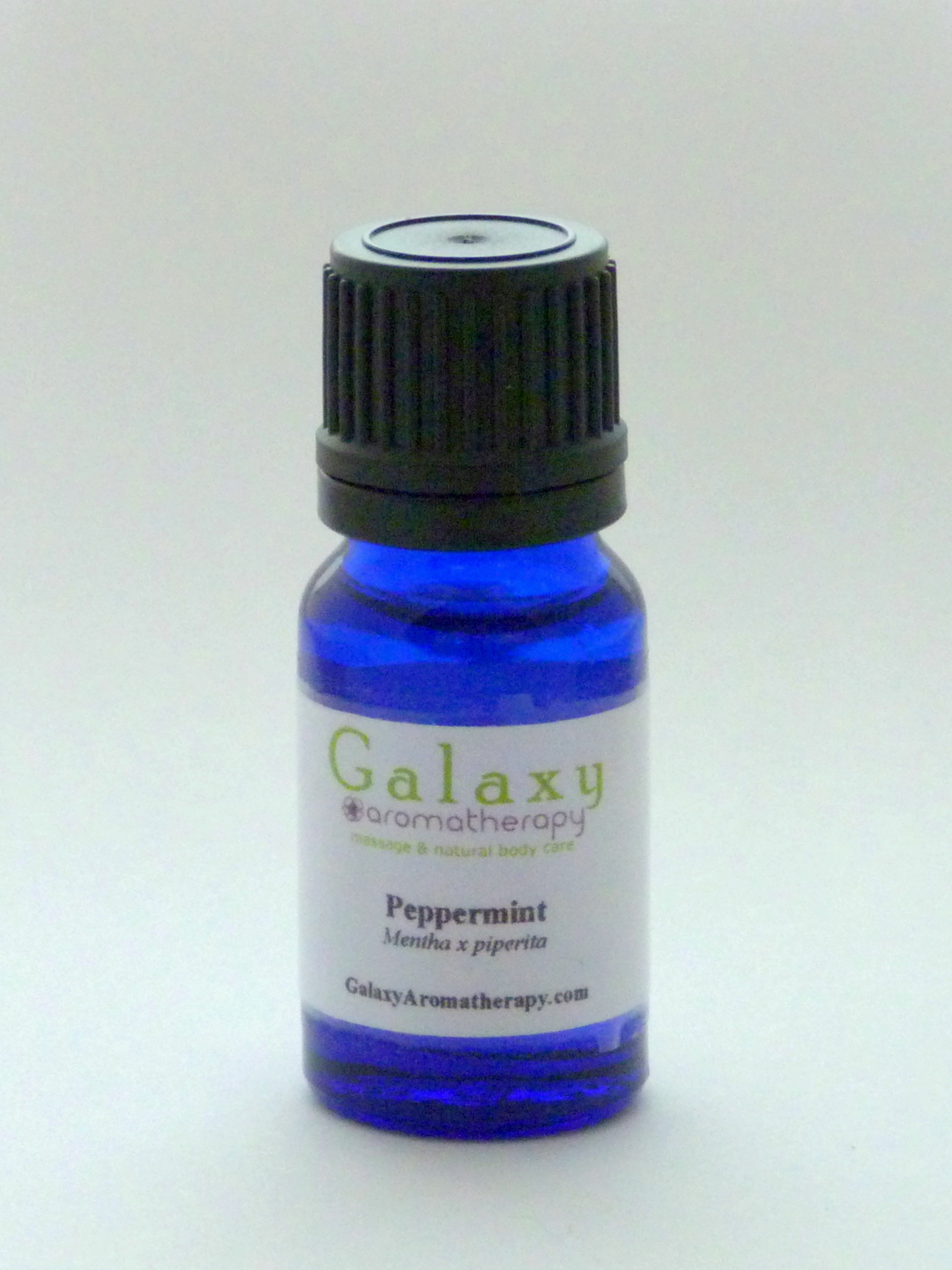Peppermint essential oil is steam distilled from the partially dried herb of Mentha x piperita. Peppermint is a perennial herb which grows from 30 to 100cm. It belongs to a genus consisting of some 20 varieties and hybrids. As the name implies, Mentha x piperita is a hybrid from the two plants Mentha spicata and Mentha aquatica. The major components of the various mints are menthol and pulegone. Cornmint, otherwise known as Japanese mint, is cheaper to produce than peppermint and spearmint, and is often used as a ‘blender’ in mint flavours and as an adulterant (*1 - see below for meaning) in peppermint oil. Cornmint is also considered more toxic than peppermint oil, as it has a higher content of pulegone.
Native to southern Europe, peppermint was taken to the USA in the early 19th century, where it is now the main producer. It is also cultivated in Argentina, Brazil, France, Italy, Morocco, Bulgaria, Holland, Spain, Germany, England, India and Australia.
Pale yellow to pale olive in colour, it has a fresh, strong, minty herbal aroma, with a depth and a sweetness to it.
According to Pliny, the Greeks and Romans crowned themselves with peppermint at their feasts, and it flavoured their sauces and wines. Culpeper said “It is useful for complaints of the stomach, such as wind and vomiting....for which there are few remedies of greater efficacy”. The mints have been used for medicinal purposes for thousands of years, but the oil itself may not have been used this way much before the 16th century, when distillation reached England. Peppermint essential oil is used extensively in food flavouring and in toothpastes, mouthwashes, soaps, detergents and perfumes.
Its main actions are as an analgesic, anti-inflammatory, antispasmodic, carminative, cephalic, diaphoretic, expectorant, hepatic, mucolytic, stimulant & vasoconstrictor. *See below for meanings.
Peppermint is an important remedy for the digestive, nervous, respiratory and musculoskeletal body systems. Peppermint essential oil is widely used for its analgesic properties in liniments for the relief of muscle pain, lumbago, bruises and contusions, joint pain and insect bites. The local anaesthetic action of peppermint essential oil is significant, making it useful for myalgia and neuralgia.
For the digestive system, peppermint is one of the most effective essential oils. It is a very effective remedy for nausea, vomiting, dyspepsia, stomach pains, diarrhoea and flatulence, and is good for relieving travel sickness, indigestion, wind and bloating. It works on the liver, helping with fat cravings/intolerance, and it’s recommended for obstructions of the bile ducts, gall bladder inflammations and severe liver damage.
Peppermint essential oil is clearing for the mind, helping people who are having trouble concentrating or have mental fatigue. It prevents congestion of the blood supply to the brain, helps clear up circulatory congestion that exists, stimulates circulation, therefore strengthening and calming the nerves. Cold compresses of peppermint can be applied to the forehead and temples to relieve headaches and migraines, if oils can be tolerated.
Gumbel says peppermint has a special affinity with the blood and lymph, and that peppermint’s refreshing effect on all the tissues lies in the liberating influence on the lymphatic system. He says the oils’ vasoconstrictive effect increases blood flow to the spleen, stimulating the regenerative activity of the spleen in the development of new blood corpuscles. The lymphatic system is activated in its function through accelerated lymph and tissue fluid circulation.
For the respiratory system, peppermint essential oil is beneficial for colds and influenza associated with fever and headaches, and it is recommended at the onset of a cold to alleviate symptoms. It is useful for sinus congestion, infection or inflammation and bronchitis.
With the cooling effect many of us know, peppermint is very helpful for soothing irritations and itching of the skin, but should be used in dilutions of 1% or less, to avoid worsenening the irritation. Davis recommends a steam treatment with peppermint essential oil to cleanse and decongest the skin. It cools by constricting the capillaries, and makes a refreshing skin tonic.
For the reproductive system, peppermint essential oil is helpful in combination with oestrogenic oils for hot flushes during menopause and helps to soothe period pains.
It is a strong vasoconstrictor, making it a beneficial oil when diluted for bruises, varicose veins or in a blend for haemorrhoids.
Peppermint essential oil can be used in mouthwashes to help remedy bad breath.
Peppermint essential oil refreshes, revives, purifies and stimulates, making it a valuable oil to use when you’re tired or low on energy. It helps promote fearlessness, quick thinking, decision-making and a willingness to get involved. It aids in dispelling pride, and is recommended to help you overcome feelings of inferiority. Associated with cleanliness, it assists people who wish to live an ethical life. Mojay says that while peppermint oil enhances concentration, it works on another level to also facilitate the digestion of new ideas. He says it is the type of oil that enhances our receptive capacities on mental and spiritual levels and would be beneficial for those in need of inspiration and insight.
Non-toxic, non-irritating, but may occasionally be sensitising. Preparations for use on the face should contain a low dilution of peppermint essential oil, low dilutions should be used and an emulsifier used in the bath, and great care should be taken to avoid touching the eyes, nose or mouth if you happen to get undiluted peppermint oil on your hands. Avoid use with children, and use only in low dilution at night to avoid wakefulness.
Blends well with citrus oils, herbal oils, eucalyptus, pine, niaouli, cedarwood and cajeput.
For free qualified advice on how to use it, email info@GalaxyAromatherapy.com
Always take care when choosing your essential oils. Look for botanical names and expiry dates on the label. They should come in dark coloured glass bottles to protect them, and have dripulator tops. Following these guidelines will help to ensure you're buying good quality, pure essential oils.
*1 - Adulterant: Lesser quality essential oil, reconstituted oil, aroma chemicals or other constituents added to a pure essential oil to “stretch” it, making it cheaper to produce. Adulterated oils should not be used in aromatherapy.
*Terms:
analgesic - relieves or diminishes pain
anti-inflammatory - alleviates inflammation
antispasmodic - prevents and eases spasms and relieves cramps
carminative - settles the digestive system and aids with gas
cephalic - stimulating and clearing for the mind
diaphoretic - promotes perspiration
expectorant - expels mucous in the respiratory system
hepatic - stimulates and aids liver function
mucolytic - dissolves or breaks down mucous
stimulant - stimulates the physiological functions of the body
vasoconstrictor – contracts blood vessel walls
Order Peppermint essential oil.
Is there an essential oil not already profiled you’d like to read about? Contact us with your request.

